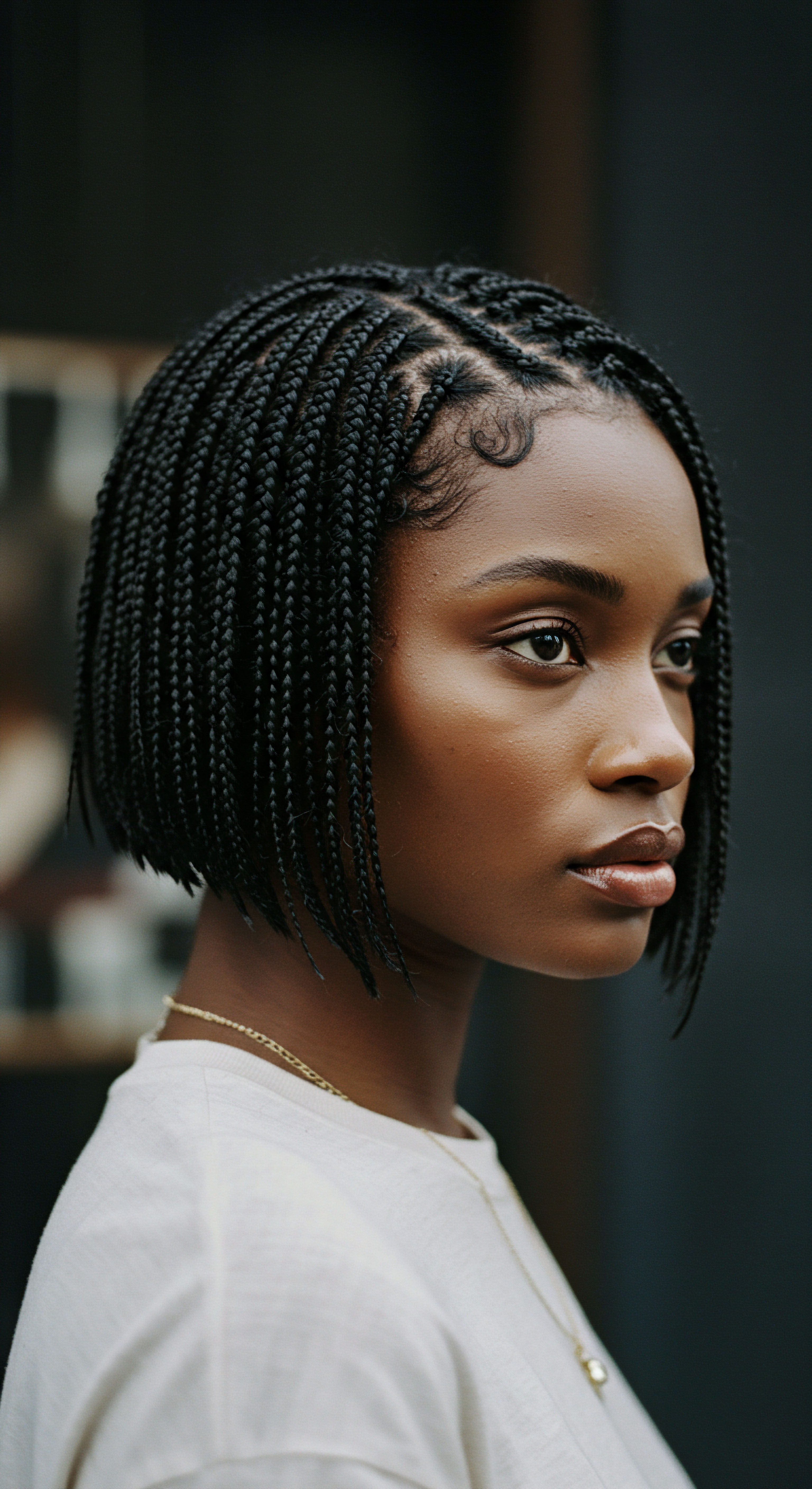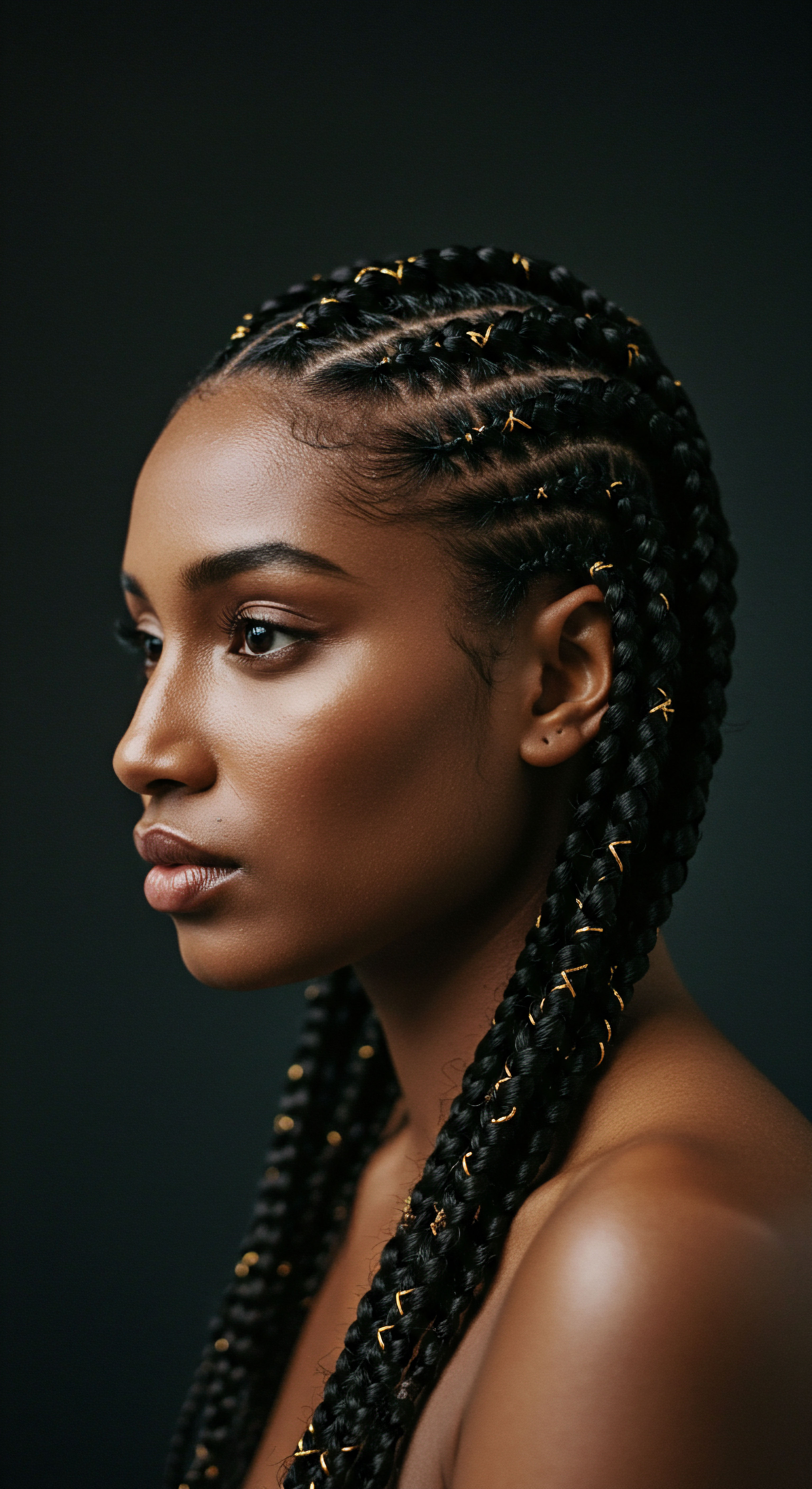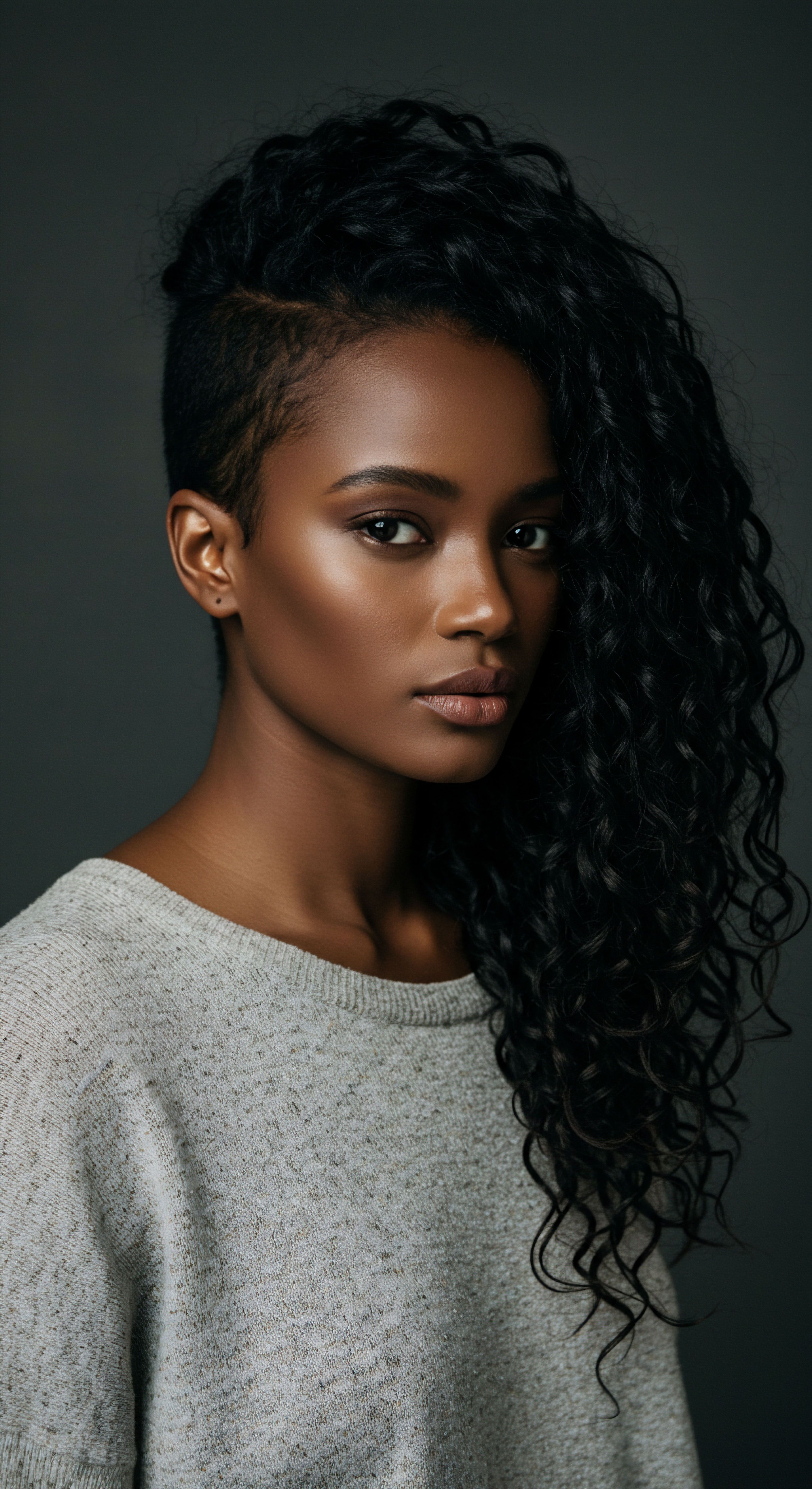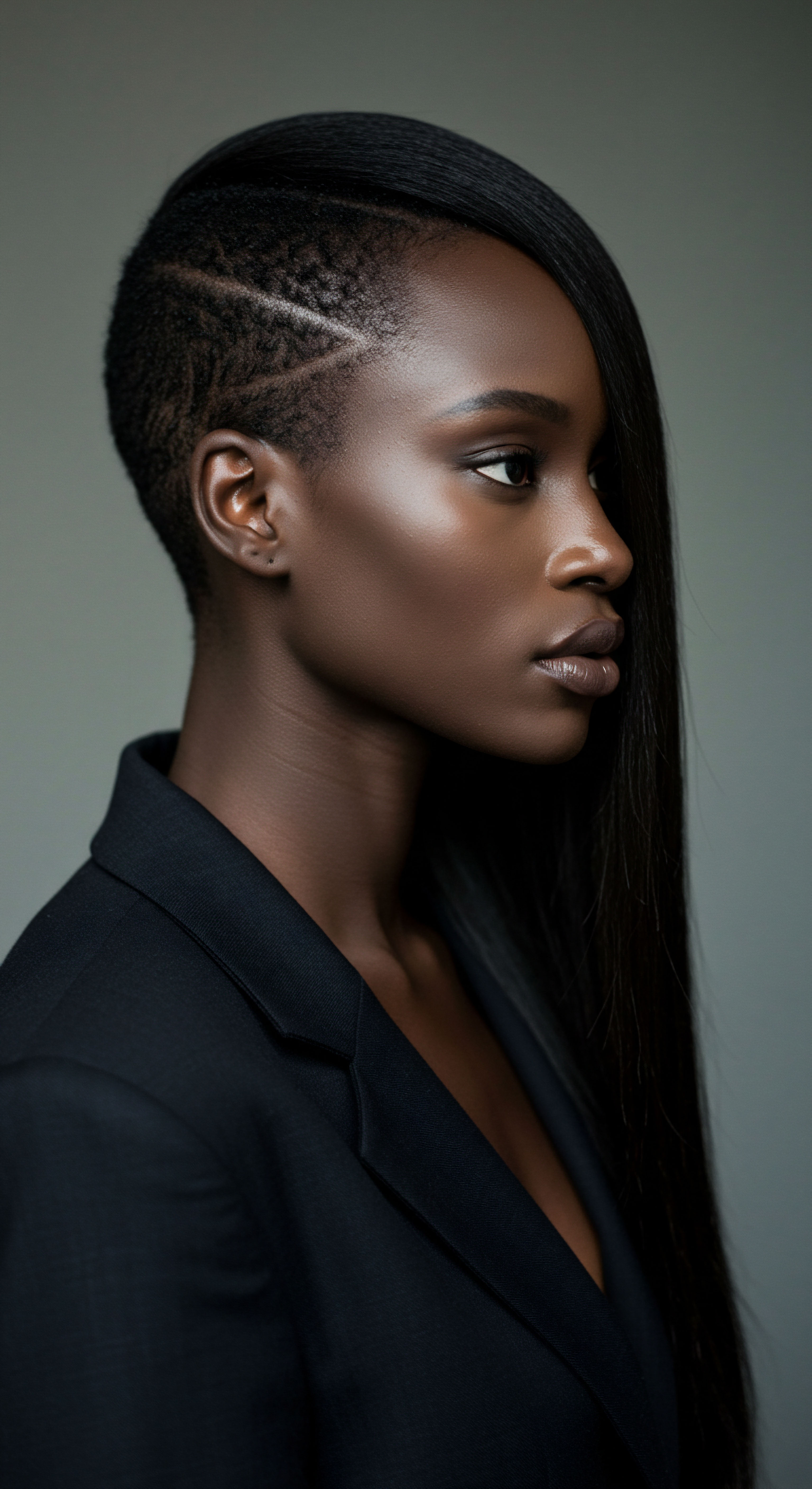
Roots
The journey of hair, from its nascent beginnings within the scalp to the vibrant strands that crown our heads, is a story written in biology and deeply felt in personal identity. We often gaze at our coils, curls, and waves, seeking answers to their health and vitality. A quiet observation often arises ❉ the simple act of touching, tending to, or even gently stimulating the scalp seems to bring a sense of well-being, a feeling that something good is stirring beneath the surface.
This gentle curiosity leads us to a fundamental question ❉ how does the age-old practice of traditional scalp massage truly aid hair growth? To truly appreciate its impact, we must first look to the hidden world beneath the skin, where hair’s very existence takes root.
The scalp, a dynamic canvas, is more than just skin; it is a complex ecosystem where each hair strand begins its life. Beneath the surface, the dermal papilla, a cluster of specialized cells, plays a central role in hair follicle regulation and growth. These cells communicate with other cells in the follicle, influencing the hair growth cycle. The scalp’s health is directly linked to the health of these foundational structures.

Hair Anatomy and Physiology
Understanding the basics of hair anatomy provides a lens through which to view the potential benefits of scalp massage. Each hair grows from a follicle, a tiny organ embedded in the skin. At the base of the follicle resides the Dermal Papilla, a small, cone-shaped structure composed of connective tissue and a network of capillaries.
This papilla is crucial because it supplies the hair follicle with blood, oxygen, and nutrients essential for hair cell proliferation and growth. Surrounding the dermal papilla are the hair matrix cells, which divide rapidly to produce the hair shaft.
The hair itself is primarily composed of keratin, a protein. The visible part of the hair, the shaft, is dead tissue. The living part lies beneath the skin, within the follicle. The sebaceous glands, also connected to the follicle, produce sebum, a natural oil that lubricates the hair and scalp, providing a protective layer.

How Does the Hair Growth Cycle Operate?
Hair growth follows a cyclical pattern, repeating throughout our lives. This cycle consists of three main phases ❉
- Anagen ❉ This is the active growth phase, where hair cells divide rapidly, and the hair shaft lengthens. This phase can last from two to seven years, largely determining hair length.
- Catagen ❉ A transitional phase, lasting about two to three weeks. Growth stops, and the hair follicle shrinks, detaching from the dermal papilla.
- Telogen ❉ The resting phase, typically lasting around three months. Old hair rests while new hair begins the growth phase. Hair shedding occurs during this period.
A healthy scalp environment supports a longer anagen phase and a balanced shedding process. When the scalp’s conditions are less than ideal, this delicate balance can be disrupted, potentially leading to increased shedding or slower growth.

Factors Influencing Hair Growth
Beyond genetics, several factors sway the rhythm of hair growth. These elements interact in a complex dance, influencing the health and vitality of our strands.
- Nutrition ❉ A balanced diet rich in vitamins, minerals, and proteins supplies the building blocks for strong hair. Deficiencies can weaken hair and slow growth.
- Blood Circulation ❉ Adequate blood flow delivers oxygen and nutrients to the hair follicles, nourishing the dermal papilla and supporting cellular activity.
- Stress Levels ❉ Chronic stress can disrupt the hair growth cycle, sometimes pushing more follicles into the resting or shedding phases. The connection between stress and hair loss is a well-observed phenomenon.
- Hormonal Balance ❉ Hormones, particularly androgens, play a significant role in hair growth and loss patterns, especially in conditions like androgenic alopecia.
- Scalp Health ❉ A clean, healthy scalp, free from excessive buildup, inflammation, or infection, provides the best environment for follicles to flourish.
Considering these foundational aspects, the intuitive appeal of scalp massage begins to crystallize. If stimulating the scalp can influence blood flow, reduce tension, and create a more hospitable environment for follicles, then its potential to support hair growth becomes a tangible concept.
The scalp, a living landscape, holds the blueprint for hair’s vitality, influenced by its internal environment and external care.

Ritual
Moving from the unseen depths of hair’s beginnings, we arrive at the tangible act, the conscious engagement with our scalp that has echoed through generations. The practice of scalp massage, a ritual as ancient as it is comforting, invites us to connect with our own being through touch. It is not merely a fleeting sensation; it is a purposeful interaction with the very foundation of our hair’s existence. This section explores the practical wisdom of scalp massage, peeling back the layers of tradition and modern understanding to reveal how this simple yet profound practice can support hair growth.
For centuries, cultures across the globe have recognized the calming and restorative qualities of head and scalp treatments. From the traditional Ayurvedic “champi” of India to the mindful techniques practiced in Japanese salons, these rituals have always held a place of honor, often passed down through families. These practices speak to a shared human understanding of the scalp’s significance beyond just hair.

The Mechanics of Scalp Massage
At its core, scalp massage involves applying pressure and movement to the scalp. This can be done with fingertips, specialized massage tools, or a combination of both. The techniques vary, but the underlying principles often remain consistent ❉ stimulate the scalp, encourage circulation, and relieve tension.
When fingertips or a tool move across the scalp, they create a gentle friction and pressure. This physical action has immediate effects on the superficial layers of the skin and the underlying tissues. The sensation itself can be profoundly relaxing, a quiet moment in a busy day.

Does Massage Increase Blood Flow to the Scalp?
A widely held belief, supported by both anecdotal evidence and scientific inquiry, is that scalp massage can enhance blood circulation. The mechanical pressure and movement during a massage can cause the blood vessels in the scalp to dilate, leading to increased blood flow to the hair follicles. This enhanced circulation delivers a richer supply of oxygen and essential nutrients, which are vital for the active growth phase of hair.
Think of the hair follicles as tiny plants; they need a steady supply of water and nutrients to grow strong. Increased blood flow acts as a more efficient delivery system for these vital components.
Consider a study conducted by Koyama and colleagues in 2016, which examined the effect of a standardized scalp massage. In this study, nine healthy men received a four-minute scalp massage daily for 24 weeks. The findings indicated a significant increase in hair thickness, which the researchers suggested was due to the mechanical stress inducing stretching forces on the dermal papilla cells in the subcutaneous tissue. This research offers a compelling data point, suggesting that the benefits extend beyond mere surface stimulation, hinting at cellular-level responses to mechanical manipulation.
The rhythmic motion of scalp massage provides a nourishing pulse, awakening the scalp’s capacity for hair vitality.

Beyond Circulation ❉ Other Benefits
While improved blood flow is a significant aspect, scalp massage offers a spectrum of benefits that collectively support hair health.
- Tension Relief ❉ The scalp muscles can hold considerable tension, often unnoticed. This tension can potentially restrict blood flow and create an unfavorable environment for hair follicles. Gentle massage can release this tension, promoting a more relaxed and open scalp.
- Stress Reduction ❉ The calming effect of scalp massage extends beyond the physical. It can lower stress hormones and promote a sense of well-being, which indirectly benefits hair health. Stress is a known contributor to hair shedding, and a practice that mitigates stress can therefore support hair retention.
- Product Absorption ❉ When applied with a massage, hair oils and serums can be distributed more evenly and potentially absorbed more effectively into the scalp. This allows the beneficial ingredients to reach the follicles and surrounding skin.
| Technique Circular Fingerpads |
| Primary Action Gentle pressure, circular motion |
| Potential Benefit Stimulates circulation, relaxes scalp |
| Technique Kneading |
| Primary Action Deeper pressure, lifting and rolling skin |
| Potential Benefit Relieves muscle tension, increases blood flow |
| Technique Tapping |
| Primary Action Light, rapid tapping with fingertips |
| Potential Benefit Invigorates scalp, enhances sensory perception |
| Technique Each technique contributes to a holistic scalp wellness practice. |
Incorporating scalp massage into a regular hair care regimen can become a cherished ritual, a moment of mindful care that supports not only the physical health of the hair but also the overall sense of calm. The gentle, consistent attention to the scalp lays a foundation for healthier hair growth, inviting vitality through deliberate touch.

Relay
Having explored the foundational elements and the practical applications of scalp massage, we now venture into a deeper stratum of understanding. The conversation around scalp massage and hair growth extends beyond simple mechanics, reaching into the subtle yet powerful interplay of cellular signals, neural pathways, and the rich tapestry of human experience. This section aims to unravel the more intricate connections, drawing from scientific inquiry and cultural wisdom to illuminate the profound impact of this ancient practice.
The human body is a marvel of interconnected systems. What seems like a localized action, such as a scalp massage, can trigger a cascade of responses that ripple through various physiological processes, ultimately influencing hair follicle behavior. The concept of mechanobiology, for instance, offers a compelling scientific lens through which to view these deeper effects.

The Role of Mechanotransduction in Hair Growth
Beyond increased blood flow, a more sophisticated mechanism at play involves Mechanotransduction. This is the process by which cells convert mechanical stimuli into biochemical signals, influencing cellular behavior and gene expression. The physical pressure and stretching forces applied during a scalp massage are mechanical stimuli that can directly influence the cells within the hair follicle, particularly the dermal papilla cells.
Research suggests that these mechanical forces can cause changes in the gene expression of human dermal papilla cells. For instance, studies have shown that stretching forces can upregulate genes associated with hair growth, such as NOGGIN, BMP4, SMAD4, and IL6ST, while simultaneously downregulating genes linked to hair loss, like IL6. This suggests a direct cellular response, where the physical act of massage translates into molecular instructions that promote hair thickness and a more robust growth cycle. This understanding shifts the narrative from a purely circulatory benefit to one that touches upon the very genetic programming of hair.

Can Scalp Massage Influence Neural Pathways?
The scalp is richly innervated with nerves, including sensory nerves and sympathetic nerves. Scalp massage, through its mechanical stimulation, can activate these neural pathways. The sympathetic nervous system, often associated with the “fight or flight” response, also plays a role in regulating hair follicle stem cell activity.
Some research points to a fascinating connection between sympathetic nerves and hair follicle stem cells. For example, studies have suggested that sympathetic nerves, by releasing neurotransmitters like norepinephrine, can influence the proliferation of keratinocytes and the initiation of hair follicle growth. While the exact relationship in the context of scalp massage requires more dedicated investigation, the idea that mechanical stimulation could subtly modulate these neural signals, thereby impacting hair growth, presents a compelling avenue for further exploration.
Scalp massage, a quiet conversation with our body, speaks in the language of cellular signals and neural rhythms.

Cultural Wisdom and Holistic Wellness
Traditional scalp massage practices, often rooted in ancient systems of medicine, intuitively understood the interconnectedness of body and mind. Cultures like those in India, through Ayurveda, and in China, through Traditional Chinese Medicine (TCM), have long integrated scalp massage into their holistic wellness approaches.
These practices often incorporate specific pressure points, herbal oils, and rhythmic movements, aiming to balance energy flow, alleviate stress, and support overall vitality, with hair health being a valued outcome. The emphasis on relaxation and stress reduction within these traditions aligns with modern scientific understanding that psychological stress can indeed impact hair growth cycles. The sustained practice of these rituals suggests a recognition of their long-term, cumulative benefits.
The wisdom of these traditions often centers on the idea that hair health is a reflection of overall well-being. A stressed mind, a body out of balance, or inadequate nourishment can all manifest in the condition of one’s hair. Scalp massage, in this context, becomes a gentle intervention that addresses not only the local scalp environment but also contributes to a broader state of calm and balance within the individual.
| Mechanism Increased Blood Flow |
| Physiological Impact Enhanced nutrient and oxygen delivery |
| Hair Growth Connection Supports active hair growth phase, follicle health |
| Mechanism Mechanotransduction |
| Physiological Impact Gene expression changes in dermal papilla cells |
| Hair Growth Connection Promotes hair thickness, influences growth-related genes |
| Mechanism Neural Stimulation |
| Physiological Impact Activation of sympathetic nerves, neurotransmitter release |
| Hair Growth Connection Potential influence on hair follicle stem cell activity |
| Mechanism Stress Reduction |
| Physiological Impact Lowered cortisol, promotion of relaxation |
| Hair Growth Connection Mitigates stress-induced hair shedding, supports overall well-being |
| Mechanism The effects of scalp massage extend from the local to the systemic. |

Beyond the Surface ❉ Long-Term Outlook
While immediate sensations of relaxation are apparent, the long-term impact of consistent scalp massage on hair growth is a subject of ongoing interest. The Koyama et al. (2016) study, though small, showed an increase in hair thickness over 24 weeks.
This suggests that sustained mechanical stimulation could lead to tangible, measurable changes over time. The self-reported benefits from surveys on standardized scalp massages for androgenic alopecia also indicate a positive perception of hair loss stabilization or regrowth among participants who consistently applied the technique.
This continuous, gentle engagement with the scalp fosters an environment where hair follicles are regularly nourished and stimulated. It represents a mindful investment in hair health, recognizing that vitality often springs from consistent, thoughtful care. The tradition, the science, and the lived experience all point towards scalp massage as a valuable practice, a quiet yet powerful gesture of care for our hair and ourselves.

Reflection
As we consider the journey of traditional scalp massage and its potential to support hair growth, we arrive at a space of contemplation. The answers we sought have unfolded from the microscopic dance of cells to the broad sweep of cultural heritage. It becomes clear that the simple act of tending to our scalp, a gesture seemingly small, holds a capacity for significant impact. It is a testament to the profound connections within our own bodies and the enduring wisdom passed through generations.
The rhythmic touch, the release of tension, the quiet moments of self-care—these elements intertwine to create a practice that nourishes more than just strands. It is a gentle reminder that care, when applied with intention and understanding, has a way of returning to us in myriad forms, perhaps even in the quiet strength of new growth.

References
- Koyama, T. Kobayashi, K. Hama, T. Murakami, K. & Ogawa, R. (2016). Standardized Scalp Massage Results in Increased Hair Thickness by Inducing Stretching Forces to Dermal Papilla Cells in the Subcutaneous Tissue. Eplasty, 16, e8.
- English, R. S. & Barazesh, J. M. (2019). Self-Assessments of Standardized Scalp Massages for Androgenic Alopecia ❉ Survey Results. Dermatol Ther (Heidelb), 9(1), 167-178.
- Chandrashekar, B. S. (2019). IADVL Textbook of Trichology. Jaypee Brothers Medical Publishers.
- Malakar, S. (2018). Trichoscopy ❉ A Text and Atlas. Jaypee Brothers Medical Publishers.
- Botchkarev, V. A. Botchkareva, N. V. Alimov, Y. I. & Alimova, M. A. (1997). Innervation of the hair follicle ❉ implications for its growth and disease. J Invest Dermatol, 108(1), 1-8.
- Zhang, Y. Liu, X. Huang, Y. Li, M. & Yang, Y. (2020). Sympathetic Nerves Regulate Hair Follicle Stem Cell Quiescence and Hair Growth. Cell, 182(2), 433-449.e17.
- Hsu, Y. C. Zhang, Y. & Liu, X. (2020). The Hair-Raising Reason for Goosebumps is Revealed. Harvard Gazette.
- Wardee. (2022). Head Massage for Hair Growth (+types and causes of hair loss). Wardee.com.
- Kong, T. et al. (2011). Neurotransmitters and hair loss. Demiroglu Science University Florence Nightingale Journal of Transplantation.
- Pang, L. et al. (2014). Recent Progress in the Understanding of the Effect of Sympathetic Nerves on Hair Follicle Growth. Frontiers in Cell and Developmental Biology, 9, 744380.